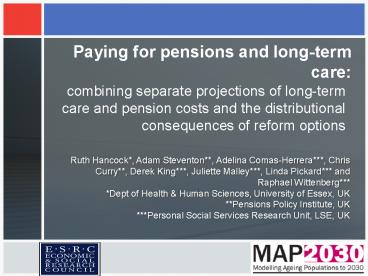Paying for pensions and longterm care: PowerPoint PPT Presentation
1 / 11
Title: Paying for pensions and longterm care:
1
Paying for pensions and long-term care
- combining separate projections of long-term care
and pension costs and the distributional
consequences of reform options
Ruth Hancock, Adam Steventon, Adelina
Comas-Herrera, Chris Curry, Derek King,
Juliette Malley, Linda Pickard and Raphael
Wittenberg Dept of Health Human Sciences,
University of Essex, UK Pensions Policy
Institute, UK Personal Social Services
Research Unit, LSE, UK
2
BACKGROUND
- In the UK
- The number of people over state pension age is
projected to rise by about 40 in the next 25
years - The number aged 80 and over, where care needs are
greatest, is projected to double - MAP2030 a 3-year programme funded by the ESRC
- This paper describes
- The process of combining existing models of
pensions and long-term care - Outputs from combining models
- Limitations and next steps
3
PENSIONS POLICY BACKGROUND
- The UK Government legislated for changes to state
- pensions (in Pensions Act 2007)
- Earnings-link the level of Basic State Pension
(BSP) - Make it easier to build up rights to state
pensions - Remove the earnings-related component of State
Second Pension (S2P) by around 2030 - Increase state pension age to 68 by 2046
- Limit the growth in means testing
- And it has proposed reforms to private pensions
- Auto-enrol most employees into saving for a
private pension - Compel employers to contribute (if the employee
does not opt-out) - Introduce a national system of Personal Accounts,
to operate alongside existing provision
4
THE PPI AGGREGATE MODEL
Accruals to State Second Pension
Cell-based projection of the future number of
workers
Accruals to private pensions
By earnings band, age, gender,
employee/self-employed, contracted-out status
Expenditure on contracted-out rebates
Age aggregated data on current entitlements to
Basic State Pension
Total expenditure on state pensions,
contracted-out rebates, total income from private
pensions, tax-relief
5
THE PPI DISTRIBUTIONAL MODEL
Static ageing of a sample of pensioner benefit
units BSP, S2P, private pension, capital,
earnings, investment income
Aggregate Model results are used to adjust
incomes year-on-year
Population projections (by age, sex, marital
status) are used to reweight benefit units
year-on-year
Calculation of income tax, entitlement to
means-tested benefits and take-up
Distribution of pensioner incomes, expenditure on
means-tested benefits, revenue from income tax
6
UK LONG-TERM CARE POLICY
- LTC funded through mix of state and private
resources - State support is subject to means tests which
vary between Scotland, England and Wales and are
different for residential and care at home - Royal Commission on LTC recommended that nursing
and personal care should be available without a
means test (free) - Free nursing care has been implemented throughout
the UK but free personal care only in Scotland - Means tests continue to be a source of discontent
- Wanless review of social care suggested a new
partnership model of paying for LTC
7
THE PSSRU AND CARESIM LONG-TERM CARE MODELS
- PSSRU Cell-based model
- Numbers of disabled older people
- Demand for long-term care services
- Long-term care expenditure public and private
- Informal care and social care workforce
- CARESIM dynamic microsimulation model
- Ages a sample aged 65 from FRS (not currently
refreshed) - Simulates the means-tests for residential care
and for home care and calculates what each older
person would pay for care should they need it - Links
- CARESIM provides trend in user contributions to
PSSRU model - PSSRU model provides weights to adjust CARESIM
results for characteristics of those who will
need care
8
WHY COMBINE PENSIONS AND LONG-TERM CARE
PROJECTIONS?
- Pensions and LTC are the two parts of public
expenditure most affected by population ageing - Pensions are transfer payments, LTC expenditure
is in exchange for care services - LTC may be paid for from transfer income
(pensions, disability benefits, means-tested
benefits etc.) - Combined public expenditure projections are
relevant to fiscal sustainability and tax burden - Comparing trends in pension income and trends in
LTC expenditure indicates adequacy (or not) of
pensioners incomes to meet care needs - Combined projections can allow for interactions
between LTC and pensions when analysing the
distribution of gains and losses from reforms
9
PROJECTIONS OF COMBINED PUBLIC EXPENDITURE ON
PENSIONS AND LTC
Current policies - post 2007 Pensions Act
Free personal care and a medium transition to a
single state pension
10
GAINS AND LOSSES FROM REFORMS BY INCOME
LTC reforms (base year)
Pension reforms
11
CONCLUSION, LIMITATIONS AND NEXT STEPS
- It is important to consider LTC and pensions
together - Above analysis is limited by neglect of
interactions (increase in pension income leads to
increase in user liability for care charges which
reduces the public cost (and limits benefits to
care recipients)) - Different assumptions/ definitions need to be
minimised projections are sensitive to
assumptions - Some parts of financing system not covered by
CARESIM but are by PPI models (and vice versa) - Will continue to adapt existing models rather
than construct a single fully-integrated model - Joint analysis of pensions and LTC is as much
about considering appropriate policies as about
modelling

